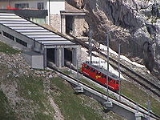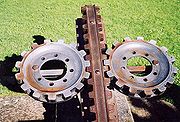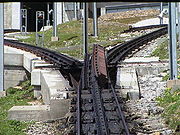
Pilatus Railway
Encyclopedia


Mountain railway
A mountain railway is a railway that ascends and descends a mountain slope that has a steep grade. Such railways can use a number of different technologies to overcome the steepness of the grade...
in Switzerland
Switzerland
Switzerland name of one of the Swiss cantons. ; ; ; or ), in its full name the Swiss Confederation , is a federal republic consisting of 26 cantons, with Bern as the seat of the federal authorities. The country is situated in Western Europe,Or Central Europe depending on the definition....
and is the steepest rack railway
Rack railway
A rack-and-pinion railway is a railway with a toothed rack rail, usually between the running rails. The trains are fitted with one or more cog wheels or pinions that mesh with this rack rail...
in the world, with a maximum gradient of 48%. The line runs from Alpnachstad, on Lake Lucerne
Lake Lucerne
Lake Lucerne is a lake in central Switzerland and the fourth largest in the country.The lake has a complicated shape, with bends and arms reaching from the city of Lucerne into the mountains. It has a total area of 114 km² , an elevation of 434 m , and a maximum depth of 214 m . Its volume is 11.8...
, to a terminus near the summit of Mount Pilatus at an altitude of 2132 m (6,994.8 ft). At Alpnachstad, the Pilatus Railway connects with steamers on Lake Lucerne and with trains on the Brünigbahn
Brünigbahn
The Brünigbahn was, until 31 December 2004, the only narrow gauge railway of the Swiss Federal Railways . On 30 June 2004, the Swiss Federal Council empowered the SBB to sell the Brünigbahn to Luzern–Stans–Engelberg-Bahn , and this company was renamed to Zentralbahn.The Brünigbahn encompasses the...
line of Zentralbahn
Zentralbahn
The Zentralbahn is a Swiss railway company that was created on January 1, 2005, with the merger of the Luzern–Stans–Engelberg-Bahn and the Brünigbahn...
.
The line is 4.6 km (2.86 mi) long, climbs a vertical distance of 1629 m (5,344.5 ft), and has a rail gauge
Rail gauge
Track gauge or rail gauge is the distance between the inner sides of the heads of the two load bearing rails that make up a single railway line. Sixty percent of the world's railways use a standard gauge of . Wider gauges are called broad gauge; smaller gauges, narrow gauge. Break-of-gauge refers...
of . Because of this system, there are no conventional points or switches
Railroad switch
A railroad switch, turnout or [set of] points is a mechanical installation enabling railway trains to be guided from one track to another at a railway junction....
on the line, only rotary switches (see photograph) and traversers
Transfer table
A transfer table, also called a traverser , is a piece of railroad equipment. It is similar in function to a turntable, though it cannot be used to turn equipment around. The table consists of a single length of track which can be moved from side to side, in a direction perpendicular to the track...
. All railway is laid on solid rock, securing rails by high-strength iron ties attached to the rock, without using any ballast
Track ballast
Track ballast forms the trackbed upon which railway sleepers or railroad ties are laid. It is packed between, below, and around the ties. It is used to facilitate drainage of water, to distribute the load from the railroad ties, and also to keep down vegetation that might interfere with the track...
. The line still uses original rack rails that are now over 100 years old. While they have worn down, it was discovered that this can be fixed by simply turning the rails over, providing a new wearing surface that would be sufficient for the next century as well. The car electric engines are used as generators to brake the car during descent, but this electricity is not reused
Regenerative brake
A regenerative brake is an energy recovery mechanism which slows a vehicle or object down by converting its kinetic energy into another form, which can be either used immediately or stored until needed...
- it is just dissipated as heat through resistance grids. Originally, the steam engines were used as compressors to provide dynamic braking
Dynamic braking
Dynamic braking is the use of the electric traction motors of a railroad vehicle as generators when slowing the Locomotive. It is termed rheostatic if the generated electrical power is dissipated as heat in brake grid resistors, and regenerative if the power is returned to the supply line...
, since the use of friction brakes alone is not practical on such a steep slopes.
History
The first project to build the line was proposed in 1873, suggesting a 1435 mm gauge and 25 % maximal gradient. However it was concluded that the project would not be economically viable. Then Eduard LocherEduard Locher
Eduard Locher was a Swiss engineer, inventor and independent contractor who received a doctorate honoris causa for his work....
, an engineer with great practical experience, proposed an alternative project with the maximal grade raised to 48 % to cut the route in half. Conventional systems
Rack railway
A rack-and-pinion railway is a railway with a toothed rack rail, usually between the running rails. The trains are fitted with one or more cog wheels or pinions that mesh with this rack rail...
at the time could not handle such gradients because the vertical cogwheel that is pressed to the rack from above may, under higher gradients, jump out of the engagement with the rack, eliminating the train’s main driving and braking power. Instead, Locher placed a horizontal double rack between the two rails with the rack teeth facing each side. This was engaged by two cogwheels carried on vertical shafts under the car. This design eliminated the possibility of the cogwheels climbing out of the rack, and additionally prevented the car from toppling over, even under the severe cross winds common in the area. The system was also capable of guiding the car without the need for flanges on the wheels. Indeed, the first cars on Pilatus had no flanges on running wheels but they were later added to allow cars to be moved through tracks without rack rails during maintenance. The line was opened using steam traction on 4 June 1889 and was electrified on 15 May 1937, using an overhead electric supply of 1550 V
Volt
The volt is the SI derived unit for electric potential, electric potential difference, and electromotive force. The volt is named in honor of the Italian physicist Alessandro Volta , who invented the voltaic pile, possibly the first chemical battery.- Definition :A single volt is defined as the...
DC
Direct current
Direct current is the unidirectional flow of electric charge. Direct current is produced by such sources as batteries, thermocouples, solar cells, and commutator-type electric machines of the dynamo type. Direct current may flow in a conductor such as a wire, but can also flow through...
.
The government provided no subsidy for the construction of the line. Instead, Locher established his own company "Locher Systems" to build the railway. The railway was built entirely with private capital and has remained financially viable throughout its life.
Pilatusbahn was named a Historic Mechanical Engineering Landmark by the American Society of Mechanical Engineers
American Society of Mechanical Engineers
The American Society of Mechanical Engineers is a professional body, specifically an engineering society, focused on mechanical engineering....
in 2001.
See also
- 800 mm (2 ft 7½ in)1 E-1 mTo help compare different orders of magnitude this page lists lengths between 10 centimetres and 100 centimetres .Distances shorter than 10 centimetres-Conversions:10 centimetres is equal to...
- Rail transport in SwitzerlandRail transport in SwitzerlandThe railways of Switzerland include and narrow gauge .*Network size: 5,063 km*standard gauge: , of which is electrified.*narrow gauge: , of which is electrified...
Sources
- Wikipedia article :de:Pilatusbahn, last updated on the 6th February 2005 at 21:11.
- Book Tramways and Light Railways of Switzerland and Austria, ISBN 0-900433-96-5, by R.J.Buckley, published by the Light Rail Transit AssociationLight Rail Transit AssociationThe Light Rail Transit Association is a non-profit organisation whose purpose is to advocate and encourage research into the retention and development of light rail and tramway/streetcar systems...
, 1984.

